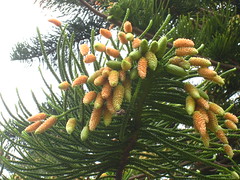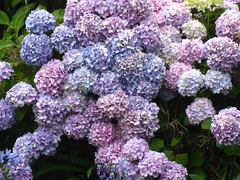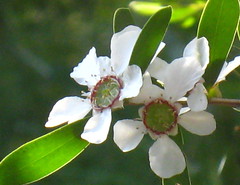A heterogeneous harvest of photos this morning.
Araucaria heterophylla. A common planting on Sydney's Northern beaches, it characterises the space between sand and road.
Here it is in flower.
A good time for fishing: raining with a low but incoming tide.
Hydrangeas on Whale Beach Road, Whale Beach.
Christmas is definitely upon us. But by Christmas time, these beautiful flowers, like most hydrangeas directly exposed, will have been burnt by the sun, after rain.
It was raining when I went for my swim and bucketing down by the time I got home.
Subscribe to:
Post Comments (Atom)




9 comments:
I realy like the picture you took of the Araucaria Heterophylla in bloom. I wonder though if it might be an Araucaria Columnaris (Cook Island Pine)? Would you mind if I used this picture in my tree-species blog? I recently found a mature Norfolk Pine tree cone and took some good pictures of what the cones and seeds look like up close. I´ve posted them to my Tree Species blog if you are interested.
Dan, by all means use the picture.
With respect to the species, I had always assumed that the Araucarias along the Northern beaches were all Norfolk Island pines, since that is what everyone calls them. I am happy to be disabused of my error, but what would make these trees A.columnaris?
Thanks
I have now looked carefully at the Cook Island pine and am certain that the tree, whose flowers are photographed, is not a Cook Island pine.
The Araucaria Heterophylla (Norfolk Island Pine) and the Araucaria Columnaris (Cook Pine) are very similar and can be difficult to tell apart. Here are a few differences. The Cook Pine´s bark tends to be more flaky with sections that curl up and peel off. The Norfolk is wider than the Cook and tends to stand straighter (A lot of the Cook Pines that I have seen tend to have a bit of a lean while the Norfolk all have a very straight trunk). The Norfolks branches are more spaced out with 1-2 meters separating one ring of branches from another. The Cooks have branches that are more densly populated giving the tree more of the look of a tall "column" . I noticed in you Flckr pics that our other picture of this tree showed quite a bit of branch density. I have been studying these two species for about three years now and I have never seen "flowers" like the ones you photographed on a Norfolk but I have seen them on the Cook Pines. I am not an expert though and would love to learn more about these trees.
here is a link with a flower like the one you photographed click here
A. Columnaris vs. A. Heterophylla.
Dan, I am still checking this out. The comments below are from Tony from Sydney (flickr ID), who is a plant taxonomist, whom I asked to look at the problem.
"Have a look at the discussion on this pic: www.flickr.com/photos/ericinsf/386161014/
Also have a look at the Araucaria shots on my Flickr pages.
"A good place to see and compare both species is the little waterfront park at Manly, south of the ferry wharf.
"N I Pine always has a strictly vertical trunk, and the lateral branches of a mature tree are very long, maybe 6-8 m -- though a tangle of shorter branches often develops close to the main trunk.
"A mature N C Pine usually has a slight bend in the trunk, and its longest lateral branches are only about hakf as long as those of a N I Pine. With age the lower ones are shed and numerous shorter branches grow from the trunk in their place."
I´ve just uploaded a new post to my blog with some pictures that show the difference between the Norfolk Island and the Cook Pine. I´ve also include you picture in the post (thanks).
Dan, you are right.
In the light of yours and Tony's comments, it appears that the eight southernmost Araucarias on Whale Beach differ from the more than 30 other Araucarias. And that they are A. columnaris.
Have a look at Tony's comments in the comment I posted 15 December 2007 and the link below for further light on the subject.
http://www.flickr.com/photos/ericinsf/386161014/
PS. Thanks for this.
Post a Comment